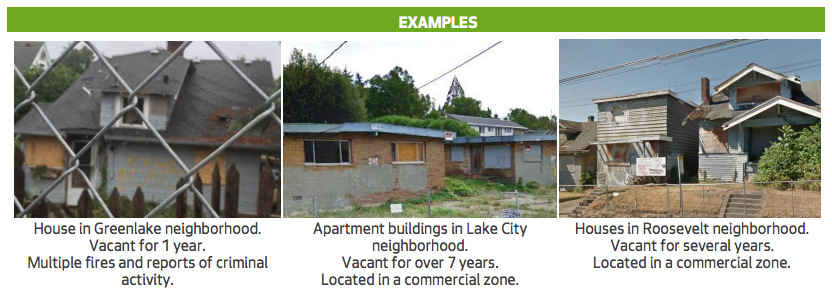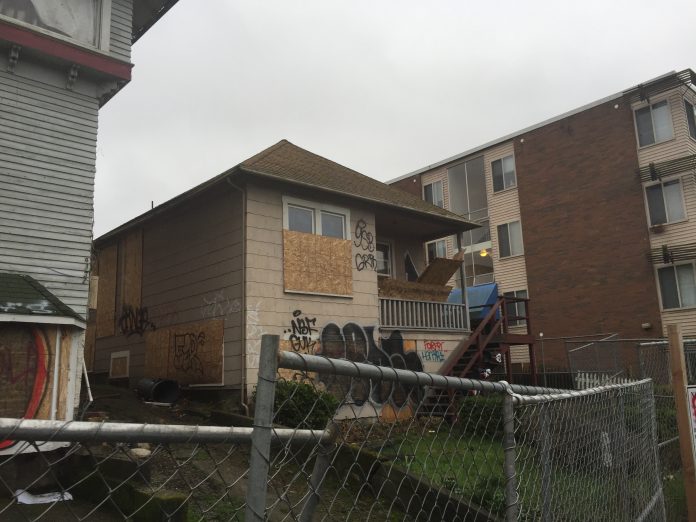Vacant buildings have become an increasing issue in Seattle over the past few years. Vacant buildings are often indication of a faltering economy and declining neighborhoods, but the opposite is the case in Seattle. New development has led to many properties being sold and vacated long before a project can break ground. Developers have frequently made contract purchases years ahead of land use permission and financing to build new towers and mixed-use blocks, often leaving properties fallow during the period between vacation and construction.
The media has repeatedly covered examples of vandalism, fires, and trespassing that have resulted from the growing number of vacant buildings across the city. Unsurprisingly, many residents and business owners have increasingly worried about the impacts that vacant buildings have on livability. Responding to these concerns, the Seattle Department of Construction and Inspections (SDCI) is proposing a package of amendments to address vacant buildings. The proposal centers on four key issues:
- Strengthening requirements for securing vacant buildings;
- Expediting the process to order removal of junk, garbage, and debris on vacant properties;
- Speeding up the process for demolishing hazardous vacant buildings; and
- Reducing the timeframe for demolishing vacant rental housing associated with a redevelopment proposal and expanding the provisions to commercial, industrial, and multi-family residential zones.
Why SDCI Is Looking At Changes
The department report by SDCI lays out the issues well:
…The housing inspection team at Seattle DCI is currently handling cases for roughly 250 properties with vacant buildings, including 62 buildings reported in 2015 (up over 400% from the previous year). Most of these properties are single-family residences. A few of the vacant structures have been determined to be unfit for human habitation or use because they have crumbling foundations, sagging roofs, rodent infestation, or other characteristics included as criteria in the [Seattle Housing Building Maintenance Code]. Many are awaiting demolition for future redevelopment. Property owners often have difficulty ensuring that their buildings are adequately maintained and kept secure in the months or years while they await redevelopment, creating opportunities for squatting and other forms of illegal entry and allowing properties to fall into a state of extreme disrepair.
When vacant buildings are entered or inhabited without the authorization of the owner, the problems created by such buildings are multiplied. This illegal use of vacant structures can create health and safety hazards for occupants, neighbors, and emergency services providers such as fire fighters and medics. According to information provided from the Seattle Fire Department, there has been a dramatic increase in fires in vacant buildings in the last few years. Vacant buildings can also be the site of illegal drug use and other criminal activities that create concerns for neighbors and the Seattle Police Department. Fire and police resources, as well as those of code enforcement, must be expended on problems at the buildings. The ever-increasing amounts of redevelopment and homelessness have only exacerbated these issues
But responding to complaints over vacant buildings can be a huge challenge for the City:
When Seattle DCI receives a complaint for an open vacant building, the Director issues an Emergency Order for the building to be secured, then works with other City departments to secure the building from illegal entry if the owner does not do so. If anyone is in the building, they must be removed before the building is secured. The owner can enter into a “trespass agreement” with the Seattle Police Department which authorizes police to remove unauthorized occupants when they are found in the building. In some such instances, the building is only vacant for a short period of time before it is demolished, and these actions sufficiently limit any further entry and address the health and safety concerns. Other properties may be left vacant for months or years, and are repeatedly illegally used as their condition deteriorates and they become more and more vulnerable to entry.
In some cases, vacant buildings pose a hazard or public nuisance necessitating removal. The process for that is also difficult:
The process to demolish an unsafe vacant structure can be equally challenging. Even very decrepit, dangerous buildings go through a several month civil process before the City can order demolition. If the property owner is absent or otherwise unresponsive and does not complete the demolition, the City must then pursue a court order and use City resources to demolish the building. In the interim, the buildings create health and safety issues and can be difficult to monitor by City code enforcement, police, and fire staff.
Of the 250 or so properties with vacant buildings, SDCI says that 50 buildings are currently being monitored by the police and fire departments due to illegal or unsafe activities and are likely not suitable for return to habitable housing stock. Instead, they would be better served by removal.

Strengthening Requirements to Secure Vacant Buildings
The Seattle Housing and Building Maintenance Code (HBMC) requires that property owners manage their properties even when they are vacant. Buildings that are vacant are required to have glazing or plywood covering all windows to protect them again vandalism and entry. Current code only requires nails and materials that are a quarter-inch thick. The proposed legislation would bump up the requirements to at least half-inch thick materials and use of screws to more tightly secure plywood or glazing.
Authority to Remove Junk, Garbage, and Debris
The HBMC could be modified to allow SDCI to issue an order or notice of violation to owners of vacant property if there are visible nuisances present like debris, litter and garbage, junk, waste, combustible materials, and overgrown vegetation. The owner would be responsible for removing these nuisance. But if the owner failed to do so, SDCI would have the authority to enter the property abate the nuisances on behalf of the public. The owner would be responsible for all costs associated with property abatement.
Authority to Remove Hazardous Buildings
The HBMC could be modified to allow SDCI to issue an emergency order to remove or demolish any building that has been the subject of two or more documented unauthorized entries in a 12-month period and that presents a danger to the public. SDCI would have to receive documented notice from the Seattle Fire Department or Seattle Police Department.
Demolition of Residential Buildings
The Seattle Land Use Code controls when demolition permits can be issued for housing units. SDCI is recommending three primary changes:
- Language requiring that vacant housing may only be demolished in single-family zones would be removed. In its place, the provisions would be revised so that vacant housing units could also be removed in other zones (e.g., multi-family residential, commercial, and industrial zones) before a development permit has been issued.
- Current language requires a former rental dwelling unit to be vacant for at least 12 months before it could be removed if a development permit has not yet been issued. The propose language would reduce the wait period to only four months.
- Additional language would be added to clarify that a proposed demolition could not “aid expansion of an adjacent non-residential use in a single-family or low-rise zone.” The purpose of the language is to limit expansion of non-residential uses in residential zones.
In explaining the sum of the changes, SDCI notes that they:
…[W]ould allow the owner of vacant housing in any zone to receive a demolition permit before the property has reached a redevelopment milestone, rather than only housing within single-family zones. As a result of the change, the owner of a multifamily, mixed use, or commercial property would be allowed to remove housing after a required vacancy period, instead of waiting until they receive a final land use permit or submit a complete building permit, a process that can take several years. The proposed amendments would also reduce the amount of time that rental housing must be vacant before the owner can receive a demolition permit without a redevelopment permit from 12 months to 4 months. This reduction would help avoid months of maintenance and safety issues associated with vacant buildings and potentially allow tenants to remain in usable housing for a longer period of time. At the same time, maintaining a required vacancy period of 4 months would help ensure that good quality rental housing is not inappropriately removed. Tenants who were residents in such buildings would still have the protection of the Just Cause Eviction Ordinance and the Tenant Relocation Assistance Ordinance where applicable.
These changes would provide a faster approval process for many of the demolition permits that the City issues, the vast majority (around 85%) of which are for residential buildings and about a third of which are located in multifamily zones. These changes would balance the need to address the nuisance and safety risks of vacant buildings with the need to protect the city’s housing stock. They would also help reduce the costs associated with monitoring and maintenance that a property owner–or City regulatory agencies–may otherwise incur. It is possible that the changes could result in the removal of some housing that may not be immediately replaced, leaving the lots undeveloped in the interim. For most neighborhoods, this will be preferable to having a dangerous vacant building at the site. And, due to the current rate of population growth, property value appreciation, and housing production that the City of Seattle is experiencing, such instances are expected to be rare.
The package of proposed code amendments should find their way before the City Council in the coming months.
Vacant Housing – Director’s Report by The Urbanist on Scribd
Stephen is a professional urban planner in Puget Sound with a passion for sustainable, livable, and diverse cities. He is especially interested in how policies, regulations, and programs can promote positive outcomes for communities. With stints in great cities like Bellingham and Cork, Stephen currently lives in Seattle. He primarily covers land use and transportation issues and has been with The Urbanist since 2014.


